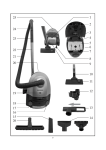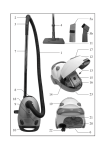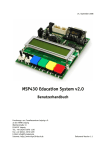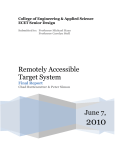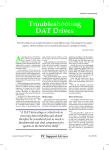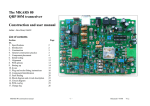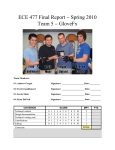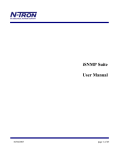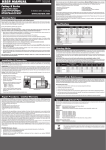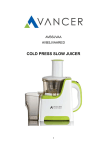Download Remote Controlled Fetch Machine
Transcript
Remote Controlled Fetch Machine Final Design Report with Diagrams EEL4924 – Senior Design 19 April 2011 Members: James Su & Brandon Grillo Project Abstract: The Remote Controlled Fetch Machine is a device designed to reinvent the way owners can exercise and entertain their dogs. It allows owners to play a game of fetch with their dog from a distance with the use of a handheld remote featuring an intuitive interface. The handheld remote features an LCD screen and buttons to navigate an onscreen menu. These buttons are used to control the behavior of the machine. Also, the remote has an accelerometer, which allows users to swivel the machine by tilting the remote left, right, or toward the user. University of Florida EEL4924 – Senior Design Spring 2011 2 Remote Controlled Fetch Machine Table of Contents Project Features Competitive Products Implementation Project Architecture Project Responsibilities User Manual Bill of Materials Gantt Chart Appendix pg. 3 pg. 4 pg. 5 pg. 7 pg. 12 pg. 12 pg. 13 pg. 14 pg. 15 List of Tables and Figures Fig. 1: Diagram of swivel and launch capabilities Fig. 2: Picture of competitive product Fig. 3: Machine design Fig. 4: Machine block diagram Fig. 5: Speed controller circuit diagram Fig. 6: Force sensor circuit diagram Fig. 7: Remote block diagram Fig. 8: Machine software flow chart Fig. 9: Remote software flow chart Fig. 10: Gantt chart pg. 3 pg. 4 pg. 5 pg. 7 pg. 8 pg. 9 pg. 9 pg. 10 pg. 11 pg. 14 Table 1: Division of labor Table 2: Bill of materials (costs) pg. 12 pg. 13 University of Florida EEL4924 – Senior Design Spring 2011 3 Remote Controlled Fetch Machine Project Features: The Remote Controlled Fetch Machine will be comprised of two major components: a remote and a device that will throw a ball. The throwing machine will have the following features: • • • • • • • • • • • Machine: Ability to throw a miniature tennis ball. The entire machine can swivel horizontally between 0° and 135°. The ball can be thrown at an angle from 0° to 35°from the horizontal. Sensor to detect the presence of a ball in the machine. “Automatic and Manual Modes” that automatically throws a ball when it is retrieved without the user’s command, or throws a ball on command. “Indoor and Outdoor Modes” that changes the distance that the ball is thrown by adjusting motor speed. Large drop zone for retrieved tennis balls to be placed. Remote: Accelerometer for tilt sensing control. A basic LCD Screen for a simple menu interface. Interface buttons to select modes and menu items. Both the machine and remote will include a transceiver to allow for RF communication The final design for the machine met and exceeded all of our initial design objectives. Several features we have added which were not part of the original basic design include the ability to launch the ball at different speeds, the ability to have varying launch angles, and the possibility of having a color LCD screen. Figure 1: Diagram showing horizontal swivel capability on the machine (Left) and diagram showing launch mechanism along with adjustable launch angle (Right). University of Florida EEL4924 – Senior Design Spring 2011 4 Remote Controlled Fetch Machine Competing Products: Commercial automatic fetch machines already exist. Two such products are the GoDogGo® G3 Fetch Machine and the Fetchtastic Automatic Fetch Machine for Dogs. These products are similar in that they both accomplish the following: • • Throw a tennis ball up to 25-30 feet Automatically throw a ball if there is one present However these machines lack some key features of the Remote Controlled Fetch Machine: • • • • Swivel position left and right Swivel trajectory up and down Distance control Wireless remote control Figure 2: Example of a competitive product (Fetchtastic). University of Florida EEL4924 – Senior Design Spring 2011 5 Remote Controlled Fetch Machine Implementation: Implementation began by selecting microprocessors for the remote and machine. The MSP430F2272 was chosen for two reasons. Its low power consumption made it a perfect fit for a handheld remote. Also, its PWM capabilities were robust and easy to configure for the machine’s needs. The Machine: The main design focus of the machine was choosing the method in which the tennis balls would be thrown. The two primary choices for implementing this were: • An arm that could launch the ball (similar to a catapult) • The ball is fed between two wheels spinning in opposite directions (similar to a baseball pitching machine) Ultimately, we chose the second method because it required less mechanical design and would be capable of throwing the ball farther. Our next major concern with the machine was how to construct it. Although plastic or metal would make the machine more durable, we chose to construct it out of wood. We chose wood because metal and plastic are very expensive and difficultto-use construction materials without the proper tools. Using wood allowed us to easily construct and modify the machine design. Finally, we chose the electrical components that allowed us to achieve the machine’s features. All movement features of the machine could be accomplished with servos with appropriate torque for the feature it was implementing. A hightorque servo was installed on the bottom of the machine that would swivel it clockwise and counterclockwise. A medium-torque servo was used to control the elevation of the ramp. A small micro servo was used to control the latch that released the balls into the throwing mechanism. Lastly, two 7.2V brushed DC motors were used with a one-direction speed controller to implement the throwing mechanism. Figure 3: Picture showing machine design. University of Florida EEL4924 – Senior Design Spring 2011 6 Remote Controlled Fetch Machine The Remote: For the remote, the goal was to make the interface as simple and intuitive as possible. We discussed various user-interface methods and eventually narrowed it down to either a glove-based control or a normal handheld remote control. With the glove control we were going to implement various types of sensors including flex sensors, touch sensors, and various types of buttons while with the handheld remote we were only going to use momentary push buttons. Ultimately, we decided to go with the handheld remote design because it was simple, effective, and cost efficient. In order to implement swivel control in the machine, we decided to use a simple 3-axis analog accelerometer for tilt-sensing in the remote. By using an analog accelerometer, we were able to use two of the eight analog-to-digital conversion pins on the MSP430 rather than take up one of the two USCI modules; this provides flexibility when connecting additional peripherals. In addition, we had an analog accelerometer available so this helped us cut back on costs. Next, we had to decide on a wireless communication interface between the remote and the machine. After weighing various options, we decided to use xBee wireless transceivers because they had a suitable range, sufficient data transfer rate, and an intuitive setup. One of the additional considerations for the project initially was to possibly include a camera of sorts on the machine that was capable of transmitting video data back to the remote. This would have required the use of a faster wireless system since the xBee data transmission rate would not have been sufficient. In the end, we decided to use the xBee modules and planned on switching to another faster wireless system if we had time to implement video transmission. Having decided on our wireless system, we then discussed display options. For our purposes, a 16x2 monochrome LCD display was enough to present the menu options and data sufficiently and was cost efficient as well. However we decided to leave room for a possible upgrade to a 128x128 color LCD display, time permitting. For the remote casing we debated between building one out of wood and ordering a premade plastic or aluminum one online. Because we had wood left over from the machine construction, we decided to go with crafting the remote casing out of wood since it would save us some costs. University of Florida EEL4924 – Senior Design Spring 2011 7 Remote Controlled Fetch Machine Project Architecture: The Remote Controlled Fetch Machine can be broken down into two projects: the wireless remote and the fetch machine. The Machine The architecture of the fetch machine is represented in the block diagram below. Figure 4: Machine block diagram. Functionality begins by initializing Timer A and B of the MSP430 to use its Pulse Width Modulation (PWM) capabilities. Each servo requires a PWM signal to operate. The pulse period for all servos is 20ms. The duty cycle for all servos varies between 600ms and 2400ms. Based on the duty cycle, the servo will rotate to a position between 0° and 180°. The motor speed controller also requires a PWM signal at the same frequency, but its duty cycle ranges from 0% to 100% of the pulse period. Once Timers A and B were initialized, the duty cycles for their corresponding servos were set for their initial positions: • The servo that swivels L/R was centered • The servo that swivels U/D was set to 0° (ramp flat) • The latch servo was set to a closed position • The speed controller was set to 0% speed The speed controller was designed using two IRF510 MOSFETs with a 12V PWM signal at the gates. When 12V is applied to the gates, current passes through the University of Florida EEL4924 – Senior Design Spring 2011 8 Remote Controlled Fetch Machine MOSFETS from the battery through the motors. By modulating the PWM duty cycle from 0% to 100%, the DC motor speed is varied from 0% to 100%. Two MOSFETS were chosen to conduct the high current demands of the motors. Below is the speed controller design. Figure 5: Speed controller circuit diagram. Once all initializations were made, the MSP430 waits for a single byte of data from the remote via an Xbee RF chip. The data codes can be found in the Appendix. The byte is decoded, and either a PWM signal is changed or a mode (automatic/manual or indoor/outdoor) is changed. If the user chooses to throw a ball, the machine enters a routine that changes the PWM signal of the speed controller and latch at certain time intervals in order to release the ball into the throwing mechanism. Once the ball is thrown, the latch returns to its closed positions and the motors are powered down. If automatic mode is selected, the MSP checks for a ball. A force sensor was used to detect the presence of a ball. The force sensor is a variable resistance that changes as force is applied. The following circuit outputs a voltage between 0 and 3.3V which connects to the MSP430 ADC (analog to digital converter) where RM = 1.5MΩ. University of Florida EEL4924 – Senior Design Spring 2011 9 Remote Controlled Fetch Machine 1 1.5Ω Figure 6: Force sensor circuit diagram. If the voltage reaches a threshold of 1.6V, then a ball is present. If a ball is present, the machine enters the throwing routine and then checks for data from the remote. This process is repeated until manual mode is selected. The program flow chart detailing this process is shown on the following page. The Remote The block diagram below illustrates the fetch machine remote’s architecture: xBee 1mW chip antenna Four momentary push buttons ADXL335 analog accelerometer MSP430f2272 16x2 monochrome LCD display Figure 7: Remote block diagram. Once the machine is powered on, the LCD screen (I/O pins for monochrome, SPI for color), analog accelerometer via the ADC on the MSP430, and xBee module via the UART on the MSP430 are initialized. The software then polls the button switches constantly to see if the user has pressed any of them. Once a button is pressed, the MSP430 sends out the corresponding command code byte to the xBee and updates the menu on the LCD screen. If the swivel button is pressed, the MSP430 continuously reads in, converts to digital, and modifies (through a linear equation) two values, one for the x axis and one for the y axis. This value is then compared to a table of discrete value ranges. Based on where each value falls, the corresponding code containing the x and y positions of the accelerometer is sent out through the xBee. Continuous position data transmission ends once swivel mode is turned off. The program flow chart detailing this process is shown on page 11. University of Florida EEL4924 – Senior Design Spring 2011 10 Remote Controlled Fetch Machine Figure 8: Machine software flow chart. University of Florida EEL4924 – Senior Design Spring 2011 11 Remote Controlled Fetch Machine Figure 9: Remote software flow chart. University of Florida EEL4924 – Senior Design Spring 2011 12 Remote Controlled Fetch Machine Project Responsibilities: Component Brandon Grillo James Su Fetch Machine Construction 60% 40% Servos, Motors, Force Sensor Fetch Machine MSP Code 100% 0% 100% 0% Remote Construction 40% 60% Buttons, LCD, Accelerometer Remote MSP Code 0% 100% 0% 100% XBee TX/RX 50% 50% Speed Controller 50% 50% Table 1: Division of labor. Overall, the division of labor closely followed the assigned responsibility table. User Manual: 1) Turn on POWER for the machine as well as the remote via the power switch. 2) Pressing the MODE button will select MANUAL or AUTOMATIC mode. a. MANUAL allows user control of the machine. b. AUTOMATIC launches balls at regular intervals until turned off. 3) Pressing the DISTANCE button will select INDOOR or OUTDOOR. a. INDOOR selection sets launch distance to approximately 15-20 feet. b. OUTDOOR selection sets launch distance to approximately 30-40 feet. 4) Pressing the SWIVEL button will allow for manual aiming of the machine. a. Tilting the remote horizontally or vertically will swivel the machine or adjust the launch angle respectively. b. SWIVEL stays on until the button is pressed again. 5) Pressing the THROW button while in ‘manual’ mode will launch a ball. University of Florida EEL4924 – Senior Design Spring 2011 13 Remote Controlled Fetch Machine Bill of Materials: Component Price Wood $25 Wheels $13 Xbee RF chip $22.95 x 2 = $45.90 Glue, Epoxy $10 Servos Motors $11.99 + $35.99 = $47.98 $23.99 x 2 = $47.98 Force Sensor $7.95 MOSFETs $1.95 x 2 = $3.90 Battery $17.99 Charger $11.49 12V Power Supply $18.99 Tennis Balls $6.98 Color LCD $34.95 Accelerometer $24.95 Buttons $4.95 Machine PCB $66 Remote PCB $66 TOTAL COST $$$ $454.01 Table 2: Table of total costs. University of Florida EEL4924 – Senior Design Spring 2011 14 Remote Controlled Fetch Machine Gantt Chart: Preliminary Research Design Phase Machine Design Remote Design Communications Design Machine Programming Remote Programming Testing and Debug Board Design and Construction Machine Assembly Remote Assembly Troubleshooting Report and Presentation Figure 10: Gantt chart which details time management and usage for the project. University of Florida EEL4924 – Senior Design Spring 2011 15 Remote Controlled Fetch Machine Appendix: Codes: Below are the data codes used for communication between the remote and the machine: Accelerometer Swivel Clockwise/Counter Clockwise: Position 1: Position 2: Position 3: Position 4: Position 5: Position 6: Position 7: Position 8: Position 9: 0x51 0x52 0x53 0x54 0x55 0x56 0x57 0x58 0x59 0° 0x5X Full Right Level 135° Full Left Accelerometer Swivel Ramp U/D: 0x6X Position 1: Position 2: Position 3: Position 4: 0x61 0x62 0x63 0x64 Modes: 0x4X Manual: Automatic: Indoor: Outdoor: Throw: 0x75 0x44 0x43 0x42 0x41 0° Level 35° Tilted back University of Florida EEL4924 – Senior Design Spring 2011 16 Remote Controlled Fetch Machine As an additional note, due to size constraint issues and necessary component placements, the PCB design for the remote control could not be milled in=house since through-hole plating is unavailable in-house. Below is the PCB design for the remote controlled as sent to Advanced Circuits:
















